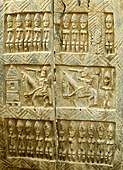Escarpment Dogon
Escarpment Dogon is a continuum of Dogon dialects of the Bandiagara Escarpment, including the standard language. There are three principal dialects:
- Toro So Tɔrɔ sɔɔ, called Bomu Tegu in the plains languages and also known as Dɔgɔsɔ,[3] is the standard variety of Dogon, which is one of thirteen official languages of Mali.
- Tommo So Tɔmmɔ sɔ, called Tombo so by Bondum Dom speakers, is spoken in a region from Kasa to Bandiagara. It is more linguistically conservative than Toro So.
| Escarpment Dogon | |
|---|---|
| Native to | Mali |
| Region | Bandiagara Escarpment |
Native speakers | 160,000 (1998)[1] |
Niger–Congo
| |
Standard forms | Tɔrɔ sɔɔ
|
| Dialects |
|
| Official status | |
Official language in | Mali |
| Language codes | |
| ISO 639-3 | Variously:dts – Tɔrɔ sɔɔdds – Donno sɔdto – Tɔmmɔ sɔdds – Kamma sɔ |
| Glottolog | esca1235[2] |
The third dialect commonly listed is two subdialects without a common name:
- Donno So Donno sɔ in the Bandiagara area, and
- Kamma So Kamma sɔ also known as Kamba So, in the Kamba area.
Hochstetler confirms that these are intelligible with each other, but not with the more populous varieties of Dogon on the neighboring plains.
While Toro So was chosen as the official standard, because it has the most in common with the largest number of Dogon languages due to its central location, and is used in educational and official contexts, Jamsay Dogon is the prestige variety and is the variety used for radio broadcasts.
Phonology
Consonants
| Labial | Alveolar | Palatal | Velar | Glottal | ||
|---|---|---|---|---|---|---|
| Stop/ Affricate |
voiceless | p | t | t͡ʃ | k | (ʔ) |
| voiced | b | d | d͡ʒ | g | ||
| Fricative | voiceless | (f) | s | (ʃ) | (h) | |
| voiced | (z) | |||||
| Nasal | m | n | ɲ | ŋ | ||
| Lateral | l | |||||
| Tap | central | ɾ | ||||
| nasal | ɾ̃ | |||||
| Approximant | central | w | j | |||
| nasal | w̃ | j̃ | ||||
- /t͡ʃ/ occurs, but only marginally.
- /ɡ/ can be realized as a fricative [ɣ] between vowel sounds /a ɔ/.
- /f z h ʔ/ can only occur among loanwords.
- /ʃ/ only occurs as an allophone of /s/ when preceding /i/.
Tommo So
Tommo So (a bipartite name for the language signifying the ethnicity or the location of the speakers, 'Tommo' and a word for language, 'So') is part of the Dogon language family comprising around twenty languages. The genetic relations of the languages of the Dogon country are complex, as geographical proximity does not necessarily involve genetic relation. "Despite the fact that Tommo So and Dogulu Dom are both spoken in the central area of Dogon country, the preliminary results of our current fieldwork suggest that Tommo So bears a closer relation to Najamba or Donno So."[5]
Geographic distribution
Tommo sɔ is thought to be spoken on the plateau between Douentza and Bandiagara by an estimated 40,000-60,000 people[6]. In terms of neighboring languages, Tommo so is bordered by Najamba-Kidinge to the northwest, by Nanga and Jamsay to the east, by Tiranige Diga to the west, and by Donno So and Dogulu Dom to the south.[5] Some dialects of Tommo So and Donno So are mutually intelligible. Donno So, based on fieldwork data, resembles an intermediate step between Tommo So and Toro So.
Notes
- Tɔrɔ sɔɔ at Ethnologue (18th ed., 2015)
Donno sɔ at Ethnologue (18th ed., 2015)
Tɔmmɔ sɔ at Ethnologue (18th ed., 2015)
Kamma sɔ at Ethnologue (18th ed., 2015) - Hammarström, Harald; Forkel, Robert; Haspelmath, Martin, eds. (2017). "Escarpment Dogon". Glottolog 3.0. Jena, Germany: Max Planck Institute for the Science of Human History.
- Apparently 'Dogon language', using the exonym Dɔgɔ 'Dogon'
- Heath, Jeffrey (2014). A Grammar of Yorno-So.
- "A Grammar of Tommo So". 2013-10-29. Retrieved 2018-05-23.
- Hochstetler, J.Lee; et al. "Sociolinguistic survey of the Dogon language area" (PDF).
References
- Blench, Roger (2005). "A survey of Dogon languages in Mali: Overview". OGMIOS: Newsletter of Foundation for Endangered Languages. 3.02 (26): 14–15. Retrieved 2011-06-30..
- Hochstetler, J. Lee; Durieux, J.A.; E.I.K. Durieux-Boon (2004). Sociolinguistic Survey of the Dogon Language Area (PDF). SIL International. Retrieved 2011-06-30.
Further reading
- McPherson, Laura (2013). A Grammar of Tommo So. Mouton Grammar Library 62. Berlin, Boston: De Gruyter. doi:10.1515/9783110301076. ISBN 978-3-11-030107-6. Retrieved 2013-10-22.
- Plungian, Vladimir (1995). Dogon. LINCOM Europa.
External links
- "Linguistics graduate student strives to preserve fading languages through her work at UCLA". The Daily Bruin. 2012-06-11. Retrieved 2012-08-07.
- Tommo So folk songs Youtube. 2013-21-07.
